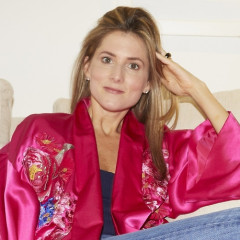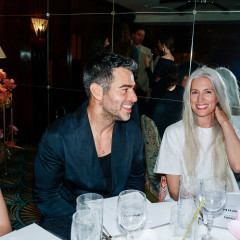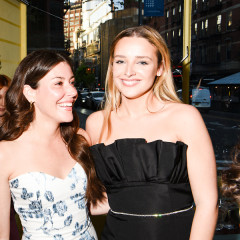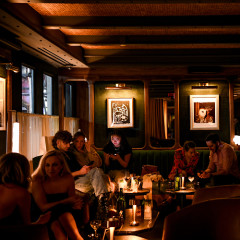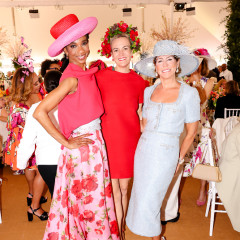Go HERE for more photos and to tag yourself and your friends!
Monday night, some artistically inclined and concerned individuals got together at the progressive collective Affinity Lab to talk about the ramifications of street art as it interacts with the law in D.C. We chatted with the discussion's hosts, Allyson Behnke and Max Fowler Cohen about why they decided to bring people together for this socratic-esque seminar.
Guest of a Guest: What generated your interest in creating this forum in which to engage in an art-law discourse? Allyson Behnke: For me it started within the context of knowing a lot of intelligent and amazing people in DC from different backgrounds and disciplines as well as a natural curiosity to understand how different life experiences affect an individual's understanding of the world around them. More often than not interesting and insightful conversation occur organically when individuals from different backgrounds go head to head on the same topic. Max and I had been playing with the idea of facilitating such conversations for a couple months, and that lead to Art x Law.
Max F. Cohen: My motive was to create high-level discussion, and DC's artistic and legal communities are both intellectually rich. I feel that cross-disciplinary conversations are ideal breeding-grounds for new ideas, because the assembled people are encouraged to explore pathways of thought that are new to them.
What role do each of you, Allyson and Max, play in the art vs. law (implied) binary? AB: I feel that art and law are manifested in everything that surrounds us. To me law dictates policy which directly and indirectly impacts the mood and the values of a community. Similarly art reflects and contributes to these values and moods. It is interesting and valuable to me to explore their intersection.
MC: The intellectual tradition that I herald from is very concerned with the law. As an undergraduate, I focused on the history of ideas, with an emphasis on North American ethical thought. While this predisposes me toward law, it has been my experience in Washington DC that the local visual arts and music scenes are asking many of the best questions.
 What conclusions or observations were made about GAIA's mural being covered up/destroyed?
AB: Over all I feel that the cover up can be contributed to miscommunication.
What conclusions or observations were made about GAIA's mural being covered up/destroyed?
AB: Over all I feel that the cover up can be contributed to miscommunication.
MC: Any work of street art is an incredibly visceral yet transient mode of expression. Like ourselves, our art comes and goes.
What talking points were addressed vis-à-vis copyright laws and street art? Do street artists have a legitimate claim to the work they produce? Or do those potential claims become lost in the intersticies of legality, public vs. private space, and the anonymity of street artists? AB: What I took away from Sherwin Siy of Public Knowledge's presentation was that the law in this particular arena is subjected to various perceptions and conditions. I personally love being surprised by new and innovative art and street art.
MC: Sherwin Siy of Public Knowledge had some great things to say about that. I can hardly do all of it justice, but essentially, the law is always at play, and so are the conditions of the streets. It's quite an intricate balance, and a chiral one.
Of the people in attendance, how many were street artists and how many were lawyers? AB: Everyone who turned out was interested in the cross-disciplinary topic.
MC: I suspect several were actually both.
Did the discussion take an "us vs. them" path or was it more of an open flow of ideas? AB: Us vs. them? If anything I would say it was similar to a college lecture or discussion where everyone was encouraged to participate.
MC: Several issues of contention were surfaced, but I was impressed with the intelligence and tenacity of our audience in addressing the tensions that arose.
 What are the D.C. laws regarding street art? Is it technically considered illegal to "deface" an abandoned building with one's artistic expression?
MC: There are, of course, regulations -but the DC government understands that for many people, art of this nature is no less a valid form of public expression than business signs and advertisements. The DC Commission on the Arts and Humanities is able to provide some legal access and even grant money for the use of certain of these spaces for artists that are willing to go through the application process. Artists can also work directly with building-owners and property managers.
What are the D.C. laws regarding street art? Is it technically considered illegal to "deface" an abandoned building with one's artistic expression?
MC: There are, of course, regulations -but the DC government understands that for many people, art of this nature is no less a valid form of public expression than business signs and advertisements. The DC Commission on the Arts and Humanities is able to provide some legal access and even grant money for the use of certain of these spaces for artists that are willing to go through the application process. Artists can also work directly with building-owners and property managers.
What role, if any, did WORN magazine play at the discussion? MC: Worn Magazine's recent article on the cover-up of GAIA's mural provided the inspiration for the conversation. We were concerned by the destruction of this artwork.
Could you talk about the choice of Affinity Lab as the site for this discussion? What role do you think Affinity Lab plays in the D.C. artistic atmosphere? AB: I work out of Affinity Lab and enjoy the positive culture that cultivates entrepreneurship. These are two reasons we choose the Lab as the location for the discussion. As a creative and an entrepreneur Affinity Lab has proved to be both a very valuable resource and positive force in my life. I am constantly surrounded by supportive DC creatives, artists and entrepreneurs... this kind of environment allows me to host events like Art x Law... I suppose you can use that is as a measure of Affinity Lab's impact on the DC artistic atmosphere. I see them as being a platform where the artistic community can grow.
MC: Affinity Lab is one of the strongest communities in DC, particularly for people in the worlds of entrepreneurship and the arts. It, and spaces like it, are the future of work. As such, we saw it as a perfect venue for encouraging a community discussion about personal expression.
Anything else you'd like to add? MC: We can't give away everything just yet, but keep an eye open for more conversations in the near future.
AB: (Affirmation nod and wink)
[GAIA photo via]


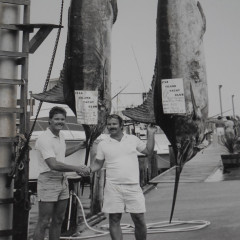
.jpg)
.jpg)
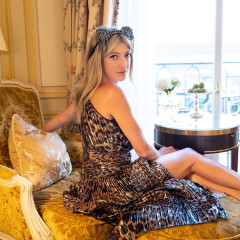

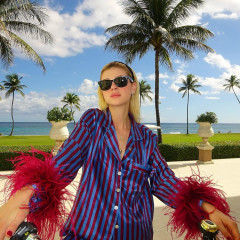
.jpg)
.jpg)
.jpg)
